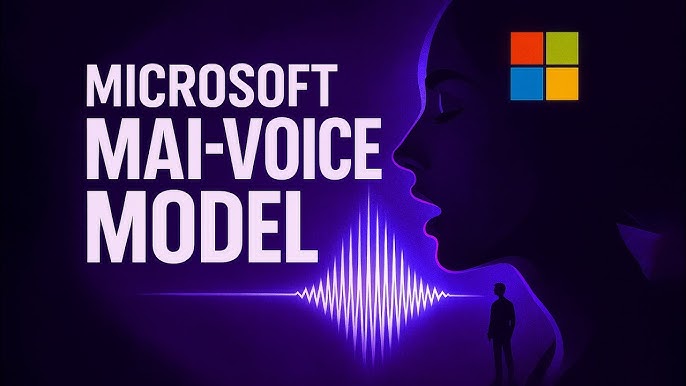Microsoft Unveils MAI-Voice-1: Lightning-Fast AI Audio Generation Model

Introduction
Microsoft has launched a major new AI model, MAI-Voice-1, shaking up the generative audio landscape with its ability to synthesize a minute of natural speech in under a second using minimal compute resources[3]. This breakthrough is set to accelerate innovation for voice assistants, media content creation, and accessibility tools, marking Microsoft's shift toward building its own AI stack after years of collaboration with OpenAI.
MAI-Voice-1: What Sets It Apart
- Unprecedented generation speed: MAI-Voice-1 can produce a minute-long audio clip in less than one second, significantly outperforming previous commercial and open-source models in both speed and resource efficiency[3].
- Minimal compute requirements: Unlike rival models that demand heavy GPU clusters, MAI-Voice-1 runs on standard consumer hardware, opening scalable AI audio to small businesses and developers.
- Versatile applications: The model is designed for speech synthesis, voiceovers, custom assistants, and media translation. Its low latency and high fidelity have drawn early interest from podcast platforms, app developers, and accessibility advocates.
Technical Innovations
Microsoft attributes the leap in performance to a novel transformer architecture optimized for audio sequence generation, as well as proprietary data filtering for cleaner training signals[3]. Industry analysts note that this positions Microsoft to compete directly with Amazon's Alexa and Google Assistant, which still rely on slower, less efficient models.
Strategic Shift: Building Microsoft's Own AI Stack
- From partnering to pioneering: This release marks Microsoft's strategic pivot away from total reliance on OpenAI models. Alongside MAI-Voice-1, the company also previewed MAI-1, its foundation LLM, on the public LMArena platform.
- Competitive implications: With Nvidia's chips increasingly restricted in China and Huawei rapidly expanding its own AI infrastructure[3], Microsoft's move to custom models signals a race for independence and control over essential AI capabilities.
Future Impact and Expert Perspectives
Experts expect MAI-Voice-1 to drive innovation in real-time communication, entertainment, and assistive technology. "This kind of speed will make truly interactive speech applications possible for millions of users," said a senior Microsoft engineer. Still, researchers caution about potential misuse and voice spoofing risks, noting that reliability and ethics remain crucial for mainstream adoption.
As generative audio becomes a pillar of modern computing, MAI-Voice-1 marks a turning point—challenging the balance of power in global AI, with speed and openness as central battlegrounds.
How Communities View Microsoft's MAI-Voice-1 Model
Microsoft's recent announcement of MAI-Voice-1 has quickly ignited discussion on X/Twitter and major AI subreddits.
Main Debate: Is ultra-fast, low-compute voice synthesis a transformative leap or a playground for deepfakes and privacy risks?
-
Excitement for Tech Progress (about 40%)
- @voiceAIdev: “Game changer for voice apps. Microsoft leaving the rest in the dust.”
- r/MachineLearning: “Results look amazing—can’t wait to experiment!”
-
Open Source & Democratization (30%)
- @ossenthusiast: “Finally standard hardware can run fast speech AI. Small devs rejoice.”
- r/OpenAI: “No more GPU bottlenecks for voice generation!”
-
Ethical Concerns & Deepfake Risks (20%)
- @datasafeguy: “Great tech, terrifying implications for voice fraud. Safeguards needed.”
- r/AIethics: “Voice cloning is about to get much easier—prepare for headaches.”
-
Microsoft’s Strategic Pivot (10%)
- @cloudstrategy: “Switching from OpenAI to own stack puts MS in direct competition with Google, Amazon.”
- r/technology: “First real sign MS is betting big on independence—interesting times ahead.”
Overall Sentiment: Mostly positive on technical innovation and access, with cautious optimism about real-world impact. Thought leaders (e.g., @drfeifei, @petewarden) highlight the need for robust security, noting the potential for both accessibility improvements and new threats.